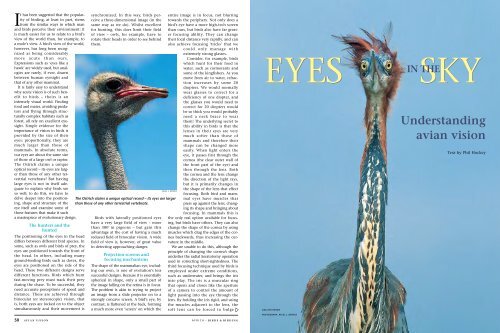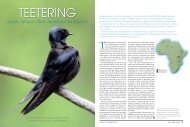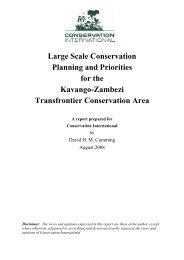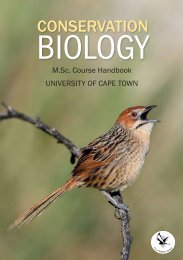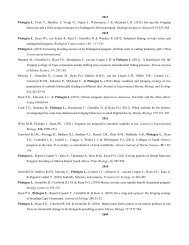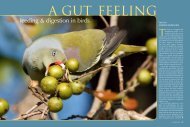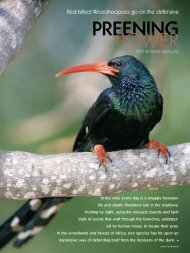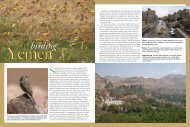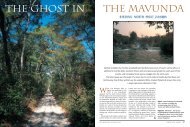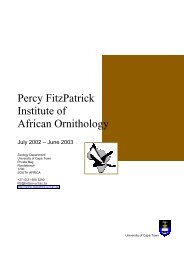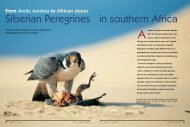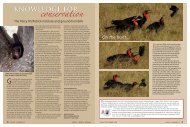Eyes in the sky: understanding avian vision
Eyes in the sky: understanding avian vision
Eyes in the sky: understanding avian vision
Create successful ePaper yourself
Turn your PDF publications into a flip-book with our unique Google optimized e-Paper software.
It has been suggested that <strong>the</strong> popularityof bird<strong>in</strong>g, at least <strong>in</strong> part, stemsfrom <strong>the</strong> similar ways <strong>in</strong> which manand birds perceive <strong>the</strong>ir environment: itis much easier for us to relate to a bird’sview of <strong>the</strong> world than, for example, toa mole’s view. A bird’s view of <strong>the</strong> world,however, has long been recognizedas be<strong>in</strong>g considerablymore acute than ours.Expressions such as ‘eyes like ahawk’ are widely used, but analogiesare rarely, if ever, drawnbetween human eyesight andthat of any o<strong>the</strong>r mammal.It is fairly easy to understandwhy acute <strong>vision</strong> is of such benefitto birds – <strong>the</strong>irs is an<strong>in</strong>tensely visual world. F<strong>in</strong>d<strong>in</strong>gfood and mates, avoid<strong>in</strong>g predatorsand fly<strong>in</strong>g through structurallycomplex habitats such asforest, all rely on excellent eyesight.Simple evidence for <strong>the</strong>importance of <strong>vision</strong> <strong>in</strong> birds isprovided by <strong>the</strong> size of <strong>the</strong>ireyes: proportionally, <strong>the</strong>y aremuch larger than those ofmammals. In absolute terms,our eyes are about <strong>the</strong> same sizeof those of a large owl or raptor.The Ostrich claims a uniqueoptical record – its eyes are largerthan those of any o<strong>the</strong>r terrestrialvertebrate! But hav<strong>in</strong>glarge eyes is not <strong>in</strong> itself adequateto expla<strong>in</strong> why birds seeso well; to do this, we have todelve deeper <strong>in</strong>to <strong>the</strong> position<strong>in</strong>g,shape and structure of <strong>the</strong>eye itself and exam<strong>in</strong>e some ofthose features that make it sucha masterpiece of evolutionary design.The hunters and <strong>the</strong>huntedThe position<strong>in</strong>g of <strong>the</strong> eyes <strong>in</strong> <strong>the</strong> headdiffers between different bird species. Insome, such as owls and birds of prey, <strong>the</strong>eyes are positioned towards <strong>the</strong> front of<strong>the</strong> head. In o<strong>the</strong>rs, <strong>in</strong>clud<strong>in</strong>g manyground-feed<strong>in</strong>g birds such as doves, <strong>the</strong>eyes are positioned on <strong>the</strong> side of <strong>the</strong>head. These two different designs servedifferent functions. Birds which huntfast-mov<strong>in</strong>g prey must track <strong>the</strong>ir preydur<strong>in</strong>g <strong>the</strong> chase. To be successful, <strong>the</strong>yneed accurate perceptions of speed anddistance. These are achieved throughb<strong>in</strong>ocular (or stereoscopic) <strong>vision</strong>, thatis, both eyes are locked on to <strong>the</strong> objectsimultaneously and <strong>the</strong>ir movement issynchronized. In this way, birds perceivea three-dimensional image (<strong>in</strong> <strong>the</strong>same way as we do). Whilst excellentfor hunt<strong>in</strong>g, this does limit <strong>the</strong>ir fieldof view – owls, for example, have torotate <strong>the</strong>ir heads <strong>in</strong> order to see beh<strong>in</strong>d<strong>the</strong>m.The Ostrich claims a unique optical record – its eyes are largerthan those of any o<strong>the</strong>r terrestrial vertebrate.Birds with laterally positioned eyeshave a very large field of view – morethan 300 ° <strong>in</strong> pigeons – but ga<strong>in</strong> thisadvantage at <strong>the</strong> cost of hav<strong>in</strong>g a muchreduced field of b<strong>in</strong>ocular <strong>vision</strong>. A widefield of view is, however, of great value<strong>in</strong> detect<strong>in</strong>g approach<strong>in</strong>g danger.Projection screens andfocus<strong>in</strong>g mechanismsThe shape of <strong>the</strong> mammalian eye, <strong>in</strong>clud<strong>in</strong>gour own, is one of evolution’s lesssuccessful designs. Because it is essentiallyspherical <strong>in</strong> shape, only a small part of<strong>the</strong> image fall<strong>in</strong>g on <strong>the</strong> ret<strong>in</strong>a is <strong>in</strong> focus.The problem is ak<strong>in</strong> to try<strong>in</strong>g to projectan image from a slide projector on to astrongly concave screen. A bird’s eye, bycontrast, is flattened at <strong>the</strong> back, form<strong>in</strong>ga much more even ‘screen’ on which <strong>the</strong>entire image is <strong>in</strong> focus, not blurr<strong>in</strong>gtowards <strong>the</strong> periphery. Not only does abird’s eye have a more high-tech screenthan ours, but birds also have far greaterfocus<strong>in</strong>g ability. They can change<strong>the</strong>ir focal distance very rapidly, and canalso achieve focus<strong>in</strong>g ‘tricks’ that wecould only manage wi<strong>the</strong>xtremely strong glasses.Consider, for example, birdswhich hunt for <strong>the</strong>ir food <strong>in</strong>water, such as cormorants andsome of <strong>the</strong> k<strong>in</strong>gfishers. As youmove from air to water, refraction<strong>in</strong>creases by some 20diopters. We would normallywear glasses to correct for adeficiency of one diopter, and<strong>the</strong> glasses you would need tocorrect for 20 diopters wouldbe so thick you would probablyneed a neck brace to wear<strong>the</strong>m! The underly<strong>in</strong>g secret tothis ability <strong>in</strong> birds is that <strong>the</strong>lenses <strong>in</strong> <strong>the</strong>ir eyes are verymuch softer than those ofmammals and <strong>the</strong>refore <strong>the</strong>irshape can be changed moreeasily. When light enters <strong>the</strong>eye, it passes first through <strong>the</strong>cornea (<strong>the</strong> clear outer wall of<strong>the</strong> front part of <strong>the</strong> eye) and<strong>the</strong>n through <strong>the</strong> lens. Both<strong>the</strong> cornea and <strong>the</strong> lens change<strong>the</strong> direction of <strong>the</strong> light rays,but it is primarily changes <strong>in</strong><strong>the</strong> shape of <strong>the</strong> lens that effectfocus<strong>in</strong>g. Both bird and mammaleyes have muscles thatpress up aga<strong>in</strong>st <strong>the</strong> lens, chang<strong>in</strong>gits shape and br<strong>in</strong>g<strong>in</strong>g aboutfocus<strong>in</strong>g. In mammals this is<strong>the</strong> only real option available for focus<strong>in</strong>g,but birds have o<strong>the</strong>rs. They can alsochange <strong>the</strong> shape of <strong>the</strong> cornea by us<strong>in</strong>gmuscles which drag <strong>the</strong> edges of <strong>the</strong> corneabackwards, thus <strong>in</strong>creas<strong>in</strong>g <strong>the</strong> curvature<strong>in</strong> <strong>the</strong> middle.We are unable to do this, although <strong>the</strong>pr<strong>in</strong>ciple of chang<strong>in</strong>g <strong>the</strong> cornea’s shapeunderlies <strong>the</strong> radial keratotomy operationused <strong>in</strong> correct<strong>in</strong>g short-sightedness. Thethird focus<strong>in</strong>g technique used by birds isemployed under extreme conditions,such as underwater, and br<strong>in</strong>gs <strong>the</strong> iris<strong>in</strong>to play. The iris is a muscular r<strong>in</strong>gthat opens and closes like <strong>the</strong> apertureof a camera to control <strong>the</strong> amount oflight pass<strong>in</strong>g <strong>in</strong>to <strong>the</strong> eye through <strong>the</strong>lens. By hold<strong>in</strong>g <strong>the</strong> iris rigid, and us<strong>in</strong>g<strong>the</strong> muscles adjacent to <strong>the</strong> lens, <strong>the</strong>soft lens can be forced to bulge NIGEL J. DENNIS50 AVIAN VISIONafrica – birds & bird<strong>in</strong>gEYESGOLIATH HERONPHOTOGRAPH: NIGEL J. DENNISSKYIN THESKYUnderstand<strong>in</strong>g<strong>avian</strong> <strong>vision</strong>Text by Phil Hockey
Over evolutionarytime, <strong>the</strong> <strong>avian</strong> eye hasdeveloped a plethoraof special and uniquefeatures which make itone of Nature’s f<strong>in</strong>estdesigns.PETER STEYNNIGEL J. DENNISthrough <strong>the</strong> open<strong>in</strong>g of <strong>the</strong> iris, achiev<strong>in</strong>gextreme curvature. The more rigidlens of a mammal precludes this focus<strong>in</strong>goption.Receiv<strong>in</strong>g <strong>the</strong> signalWhen light enters <strong>the</strong> eye and falls on<strong>the</strong> ret<strong>in</strong>a, an image is perceived anddecoded by <strong>the</strong> bra<strong>in</strong>. The ret<strong>in</strong>a thusacts as an <strong>in</strong>terface between <strong>the</strong> outsideworld and <strong>the</strong> biological computer, <strong>the</strong>bra<strong>in</strong>. Light falls on to, and triggers,nerve cells <strong>in</strong> <strong>the</strong> ret<strong>in</strong>a. The signal ispassed from <strong>the</strong> ret<strong>in</strong>a along a nervecha<strong>in</strong>. There are two types of light- orphoto-sensitive cells <strong>in</strong> <strong>the</strong> ret<strong>in</strong>a – rodsAbove The large, frontally positionedeyes of owls provide <strong>the</strong>m with excellentstereoscopic <strong>vision</strong>. Because <strong>the</strong>se birdshunt primarily <strong>in</strong> low light conditions, <strong>the</strong>irret<strong>in</strong>as are rich <strong>in</strong> rods. The Spotted EagleOwl shown here is a typical example.Below <strong>Eyes</strong> positioned on <strong>the</strong> side of <strong>the</strong>head, as <strong>in</strong> this Namaqua Dove, donot work well for stereoscopic <strong>vision</strong> butcan detect <strong>the</strong> approach of dangerfrom almost any quarter.PETER STEYNand cones. These differ <strong>in</strong> <strong>the</strong> circuitrythrough which <strong>the</strong>y pass messages to<strong>the</strong> bra<strong>in</strong>. In <strong>the</strong> case of rods, severalconverge on a s<strong>in</strong>gle nerve cha<strong>in</strong> to <strong>the</strong>bra<strong>in</strong>. This design <strong>in</strong>creases <strong>the</strong> strengthof <strong>the</strong> signal through a multiplier effect.Cones, by contrast, each have <strong>the</strong>ir owndedicated l<strong>in</strong>e to <strong>the</strong> bra<strong>in</strong>. Because <strong>the</strong>strength of <strong>in</strong>com<strong>in</strong>g light determ<strong>in</strong>es<strong>the</strong> strength of signals sent to <strong>the</strong> bra<strong>in</strong>(which is why your eyes hurt <strong>in</strong> brightlight), cones are most effective undergood light conditions – send<strong>in</strong>g very clearimages to <strong>the</strong> bra<strong>in</strong> – and rods work bestunder low light conditions – amplify<strong>in</strong>g<strong>the</strong> signal but los<strong>in</strong>g some of <strong>the</strong> def<strong>in</strong>ition.Nocturnal birds have ret<strong>in</strong>as rich<strong>in</strong> rods, and diurnal birds have ret<strong>in</strong>asrich <strong>in</strong> cones.High-quality reception...and magnify<strong>in</strong>g glassesMammals also have rods and cones <strong>in</strong><strong>the</strong> ret<strong>in</strong>a, so <strong>the</strong>se alone are not a reasonfor birds’ excellent eyesight. Theirgreater efficiency <strong>in</strong> birds can only beunderstood <strong>in</strong> conjunction with <strong>the</strong> way<strong>in</strong> which <strong>the</strong> eye receives nutrition(without which it could not function).The mammalian ret<strong>in</strong>a is richly suppliedwith blood vessels. These take up spaceand <strong>the</strong>refore compromise <strong>the</strong> numberof rods and cones that can be accommodated<strong>in</strong> <strong>the</strong> ret<strong>in</strong>a. There is no bloodsupply to <strong>the</strong> <strong>avian</strong> ret<strong>in</strong>a, so that it canbe dedicated entirely to receiv<strong>in</strong>g andpass<strong>in</strong>g on light signals. Nutrition isprovided to <strong>the</strong> bird’s eye by way of asmall, blood-rich structure called <strong>the</strong> pecten. So as not to disrupt picturereception, <strong>the</strong> pecten is anchored to asmall area of <strong>the</strong> ret<strong>in</strong>a called <strong>the</strong> opticdisc: this is where <strong>the</strong> nerves from <strong>the</strong>photo-sensitive cells come toge<strong>the</strong>r andleave <strong>the</strong> eye en route to <strong>the</strong> bra<strong>in</strong>. Thereare no rods or cones at <strong>the</strong> po<strong>in</strong>t wherethis nerve cable leaves <strong>the</strong> eye, so <strong>vision</strong>is not impaired. In both birds and mammals,<strong>the</strong>re is a small area <strong>in</strong> <strong>the</strong> middleof <strong>the</strong> ret<strong>in</strong>a that is thicker than <strong>the</strong> rest.This is a region particularly rich <strong>in</strong> conesand is unimag<strong>in</strong>atively termed <strong>the</strong> ‘centralarea’.In birds, <strong>the</strong> central area may have adepression with<strong>in</strong> it (called a fovea).This acts as a small magnify<strong>in</strong>g glass,and projects a slightly enlarged imageon to <strong>the</strong> ret<strong>in</strong>a. Some birds which pursueprey at high speed have two foveas<strong>in</strong> each eye – <strong>the</strong>se are thought to help<strong>in</strong> stereoscopic <strong>vision</strong>.Colour <strong>vision</strong> and beyondMany birds are brightly coloured and frequentlyuse <strong>the</strong>se colours <strong>in</strong> social ando<strong>the</strong>r displays. This <strong>in</strong> itself is good evidencethat <strong>the</strong>y have colour <strong>vision</strong>. Thecolour image is provided by visual pigments<strong>in</strong> <strong>the</strong> cones. In addition to <strong>the</strong>se,however, birds also have brightly colouredoil droplets <strong>in</strong>corporated <strong>in</strong> <strong>the</strong>ir cones. Itis thought that <strong>the</strong>se work not <strong>in</strong> produc<strong>in</strong>ga colour image per se, but by act<strong>in</strong>g asfilters to enhance contrast <strong>in</strong> <strong>the</strong> sameway as photographic filters do. Thus, yellowdroplets would remove much of <strong>the</strong>blue from <strong>the</strong> background, enhanc<strong>in</strong>gcontrast between an object and a blueAbove Birds which hunt <strong>the</strong>ir preyunder water, such as this Pied K<strong>in</strong>gfisher,must be able to cope with 20 dioptersof refraction – much more than <strong>the</strong> humaneye can handle.Below A Lesser Double-collaredSunbird feeds at an erica. Birds canprobably sense ultraviolet light and mayuse this ability <strong>in</strong> <strong>the</strong> same way asnectar-feed<strong>in</strong>g <strong>in</strong>sects to detect ultraviolet‘nectar-guides’ on flowers.PETER STEYN<strong>sky</strong>. Red droplets would remove much of<strong>the</strong> green, which would help birds search<strong>in</strong>gfor <strong>in</strong>sects <strong>in</strong> a forest.Unlike us, birds are sensitive to ultravioletlight. They also seem to be able todetect polarized light, and this abilitymay be particularly important <strong>in</strong> navigation.The pattern of light polarization <strong>in</strong><strong>the</strong> <strong>sky</strong> changes dur<strong>in</strong>g <strong>the</strong> day as <strong>the</strong>sun’s position moves. This may wellhelp migrat<strong>in</strong>g birds which use <strong>the</strong> sun’sposition as a compass – especially onovercast days.At <strong>the</strong> beg<strong>in</strong>n<strong>in</strong>g of this article, I statedthat birds were highly visual animals.Over evolutionary time, <strong>the</strong> <strong>avian</strong> eyehas developed a plethora of special andunique features which make it one ofNature’s f<strong>in</strong>est designs. Perhaps we arecorrect <strong>in</strong> draw<strong>in</strong>g <strong>the</strong> analogy between<strong>the</strong> way <strong>in</strong> which man and birds perceive<strong>the</strong> environment, <strong>the</strong> differencebe<strong>in</strong>g that birds see it with a clarity wecould only dream of!Many birds are brightlycoloured and frequentlyuse <strong>the</strong>se colours <strong>in</strong>social and o<strong>the</strong>rdisplays. This <strong>in</strong> itself isgood evidence that <strong>the</strong>yhave colour <strong>vision</strong>.52 AVIAN VISIONafrica – birds & bird<strong>in</strong>g1997 – volume 2, number 6AVIAN VISION53


